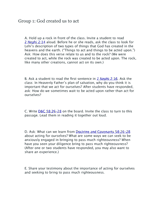This lesson was super, super easy. The manual had a group activity that worked out perfectly. I was like the others who reported back on the Facebook group -- the activity went too long and bled into the following day's lesson.
I didn't make a handout for this lesson because .... drum roll ... the church already provided one! I rarely use the online lesson planner (I know -- you'd think someone as nerdy as I am would live on it) but this time I happened to be on it and found a link to the group activity handout already formatted and ready to go. It was ugly, but I used it anyway since it meant I didn't have to do any extra work. Here's the link:
https://www.lds.org/bc/content/shared/content/images/gospel-library/manu...
I found some others by experimenting with the URL, too. Keep your eyes peeled on the online site for these ready-made helps.
I printed the four pages on four different colors of cardstock. I also made a note on one of each of the individual lettered activities to show which could easily be split between 2 people, since I have more than 20 students. Worked perfectly. By the end the kids were really on a roll and doing great. I ended up with all 24 students in class both days, and the structured lesson helped things go well.
I'd love to see some clearly laid out lessons like this for Come, Follow Me, so that we can begin to get kids used to asking questions and noting responses on a board as kind of a training-wheels exercise for later gospel teaching.
Divide students into four groups. Give each group one of the following sets of instructions to help them prepare to teach (before class, prepare handouts containing these instructions). If the class has fewer than four students, give a set of instructions to each student and teach the material contained in the remaining sets yourself.
Each set of instructions contains five assignments. Encourage all students to participate by ensuring that each person in each group receives an assignment. In groups of more than five, students may share assignments. In groups with fewer than five students, some individuals will need to do more than one assignment. Inform students that they will have about three minutes to prepare and that each group will have about five minutes to teach.
Group 1: God created us to act
- A.
Hold up a rock in front of the class. Invite a student to read 2 Nephi 2:14 aloud. Before he or she reads, ask the class to look for Lehi’s description of two types of things that God has created in the heavens and the earth. (“Things to act and things to be acted upon.”) Ask: How does this verse relate to us and to the rock? (We were created to act, while the rock was created to be acted upon. The rock, like many other creations, cannot act on its own.)
- B.
Ask a student to read the first sentence in 2 Nephi 2:16. Ask the class: In Heavenly Father’s plan of salvation, why do you think it is important that we act for ourselves? After students have responded, ask: How do we sometimes wait to be acted upon rather than act for ourselves?
- C.
Write D&C 58:26–28 on the board. Invite the class to turn to this passage. Lead them in reading it together out loud.
- D.
Ask: What can we learn from Doctrine and Covenants 58:26–28 about acting for ourselves? What are some ways we can seek to be anxiously engaged in bringing to pass much righteousness? When have you seen your diligence bring to pass much righteousness? (After one or two students have responded, you may also want to share an experience.)
- E.
Share your testimony about the importance of acting for ourselves and seeking to bring to pass much righteousness.
Group 2: Good enticement and evil enticement
- A.
Invite a student to read the second sentence in 2 Nephi 2:16. Ask the class: What does the word entice mean? (To invite, persuade, or attract.)
- B.
Ask the class: What are some ways Heavenly Father entices us to do good? (Students might mention promptings from the Holy Ghost, promised blessings for obeying the commandments, and teachings of latter-day prophets.)
- C.
Read 2 Nephi 2:17–18 aloud, and invite students to follow along in their scriptures. Ask them to identify what the devil seeks for all of us. (He wants us to be miserable.)
- D.
Ask: How can you know which enticements come from God and which come from the devil? (As part of this discussion, you may want to refer to Moroni 7:16–17.) After the class has responded, ask: What are some examples of things that entice people to do wickedly and that lead to misery?
- E.
Share your testimony about God’s enticements leading to goodness and happiness and the devil’s enticements leading to wickedness and misery. As part of your testimony, you may want to share an experience to illustrate how you know this is true.
Group 3: We are accountable for our choices
- A.
Read this statement to the class:
“You are free to choose and act, but you are not free to choose the consequences of your actions. The consequences may not be immediate, but they will always follow” (True to the Faith: A Gospel Reference [2004], 12).
Ask: What are some examples of consequences that may not be immediate but that may come? (One possible answer is that cancer often results from smoking.)
- B.
Invite students to read 2 Nephi 2:26–27 silently, looking for words and phrases that show future consequences of choices we make now. Ask students to report on what they find. (Answers may include “punishment of the law at the great and last day,” “liberty,” “eternal life,” “captivity,” “death,” and “miserable.”) Write students’ responses on the board.
- C.
Ask: Why do you think it is important for us to understand the consequences of our choices in this life? After students have responded, ask: How can knowing these consequences motivate us to make righteous choices?
- D.
Point out that in 2 Nephi 2:27, Lehi says that we “are free to choose liberty.” Ask: In your experience, how do righteous choices help us remain free to choose? Can you offer examples of this? (Be prepared to share an example of your own.)
- E.
Share your testimony that we are accountable to God for our choices and that consequences always follow our choices.
Group 4: Choosing the good part
- A.
Have a student read 2 Nephi 2:28 aloud. Ask the class to look for four things Lehi desired for his sons. After the verse has been read, invite students to share what they have found.
- B.
Ask: What are some ways we can look to the great Mediator, Jesus Christ, to help us make righteous choices?
- C.
Invite a student to read 2 Nephi 2:29 aloud. Ask the class: How can our choices give the devil power to take us captive? As part of this discussion, point out that many of Satan’s temptations target “the will of the flesh,” or our physical appetites. When people give in to these temptations, they can become addicted to harmful substances and behaviors. Read the following statement by Elder Russell M. Nelson of the Quorum of the Twelve Apostles:
“From an initial experiment thought to be trivial, a vicious cycle may follow. From trial comes a habit. From habit comes dependence. From dependence comes addiction. Its grasp is so gradual. Enslaving shackles of habit are too small to be sensed until they are too strong to be broken. … Addiction surrenders later freedom to choose” (“Addiction or Freedom,” Ensign, Nov. 1988, 6–7).
Share your testimony about righteousness leading to freedom from harmful habits and addictions.
- D.
Read 2 Nephi 2:30 to the class. As they follow along, invite them to focus on these words: “I have chosen the good part.” Ask: What does this statement teach about Lehi?
- E.
Ask students to ponder the following questions: Whom do you know who has “chosen the good part” like Lehi? In what ways would you like to follow this person’s example? After students have had time to ponder, ask for one or two to share their thoughts. Then share your own thoughts.





